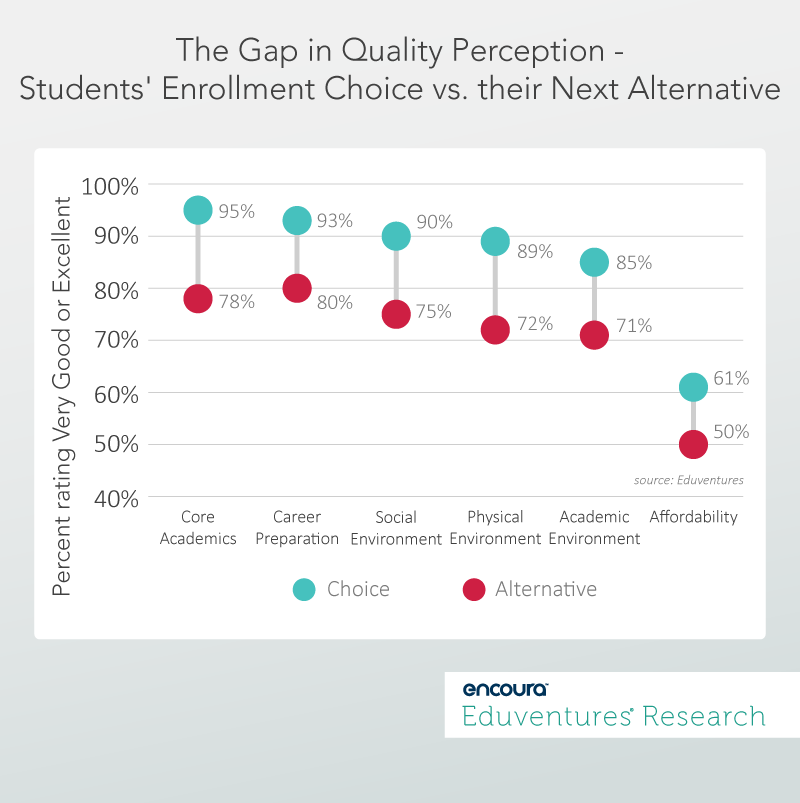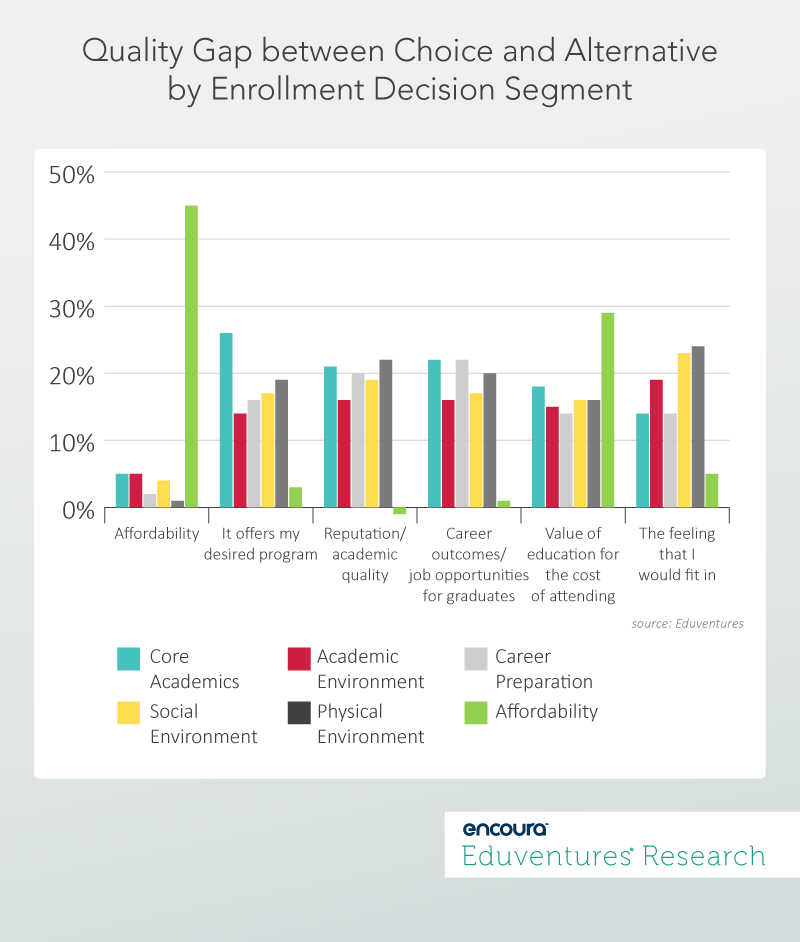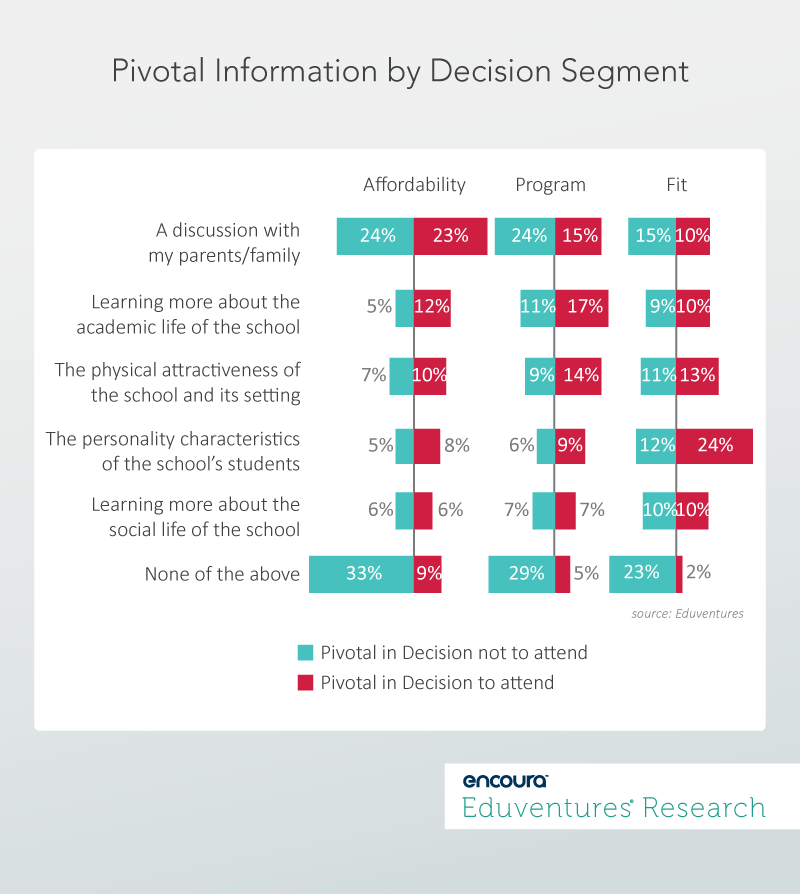The most difficult task for admissions staff during the critical yield phase of the enrollment cycle is to get that student who is very close to enrolling to see the opportunity before them without reservation. Effective targeted yield campaigns help individual students cross their personal gaps in perception, alleviate their anxieties about their choice, and motivate them to deposit.
Eduventures Survey of Admitted Students helps institutions to understand the nature of important perception gaps and to develop appropriate strategies for addressing these gaps for traditional-aged undergraduates. Our 2017 survey of admitted students, this year gathered through the My College Options™ database of college-bound high school seniors, gained more than 90,000 respondents nationally. To put this in perspective, this year’s survey garnered three times more responses than our surveys in prior years. We estimate this to be 8% of all first-time freshmen attending colleges or universities in the U.S. This rich data about student enrollment choice can illuminate ways for institutions to move students who are close to enrolling to deposit through more targeted yield strategies.
Let’s start with an overview of differences students see in the quality of their choice and their alternative choice. As you would expect, students always give their enrolling institution higher marks than their alternative choice. But the size of the gap is telling. On average in the national sample, the largest gaps in perception are in the area of quality of core academics, and the physical environment. The smallest gap nationally is in the area of affordability.


 For example, for those who make a decision based on affordability, a parent and family-focused strategy is most relevant. You might hold an admitted student and parent event that’s all about how families can afford your college. Certainly, any admitted student could attend, but personal outreach to students and parents who you know to be concerned about affordability can bring those who need the information the most to the table. Your event, virtual or in-person, could feature not only financial aid and admissions staff, but students and parents who have worked through the same affordability issues. This type of event would allow students and families concerned with affordability to not only learn about the resources of your institution, but also meet real people who have successfully negotiated affordability issues. Then, imagine how other campaigns or events might reach out to students with different concerns. You want to deliver the right information to the right people at the right time.
For example, for those who make a decision based on affordability, a parent and family-focused strategy is most relevant. You might hold an admitted student and parent event that’s all about how families can afford your college. Certainly, any admitted student could attend, but personal outreach to students and parents who you know to be concerned about affordability can bring those who need the information the most to the table. Your event, virtual or in-person, could feature not only financial aid and admissions staff, but students and parents who have worked through the same affordability issues. This type of event would allow students and families concerned with affordability to not only learn about the resources of your institution, but also meet real people who have successfully negotiated affordability issues. Then, imagine how other campaigns or events might reach out to students with different concerns. You want to deliver the right information to the right people at the right time.

But the gaps are different for differently motivated students
The information above tells us something about the overall decision environment, but in reality, students weigh some factors more heavily than others. Our survey asks admitted students to put a stake in the ground and tell us what the most important final factor was in their enrollment decision. More than 70% of all students name their final selection criteria as one of these six factors:- Affordability
- Availability of a desired program
- Reputation/academic quality
- Career outcomes/job opportunities for graduates
- Value of education for cost of attending
- Feeling of fit

What kind of influence do you have to address the gap?
Ideally, your yield campaigns should be able to target and deliver the right information to students based on their biggest concerns, if you know what they are. Even so, what kind of information best fills the gap for students? Our survey asked students to tell us what information outside of the critical information on academic quality, career preparation, and affordability was pivotal in making their final decision to attend or not attend a school. Again, there are many different types of information that students consider, but these are the top mentions for three of the decision segments above, as an illustration of differentiated yield strategies. For example, for those who make a decision based on affordability, a parent and family-focused strategy is most relevant. You might hold an admitted student and parent event that’s all about how families can afford your college. Certainly, any admitted student could attend, but personal outreach to students and parents who you know to be concerned about affordability can bring those who need the information the most to the table. Your event, virtual or in-person, could feature not only financial aid and admissions staff, but students and parents who have worked through the same affordability issues. This type of event would allow students and families concerned with affordability to not only learn about the resources of your institution, but also meet real people who have successfully negotiated affordability issues. Then, imagine how other campaigns or events might reach out to students with different concerns. You want to deliver the right information to the right people at the right time.
For example, for those who make a decision based on affordability, a parent and family-focused strategy is most relevant. You might hold an admitted student and parent event that’s all about how families can afford your college. Certainly, any admitted student could attend, but personal outreach to students and parents who you know to be concerned about affordability can bring those who need the information the most to the table. Your event, virtual or in-person, could feature not only financial aid and admissions staff, but students and parents who have worked through the same affordability issues. This type of event would allow students and families concerned with affordability to not only learn about the resources of your institution, but also meet real people who have successfully negotiated affordability issues. Then, imagine how other campaigns or events might reach out to students with different concerns. You want to deliver the right information to the right people at the right time.
Targeted yield strategies to address the gap
There is a lot more to be learned from our Survey of Admitted Students. Mining this data will help you understand how students who are close to choosing your institution make their final decision which in turn will help you target your yield strategies much more effectively. Once you understand the data, though, you must take action to develop those strategies. Here are four things that will get you started in developing more targeted yield strategy:- Know which students are close to choosing your institution. If you don’t know who is on the fence, you can’t move them off of the fence. You can use sophisticated methods, like enrollment modelling, to know this, or you can use old-fashioned grass roots personal outreach to get a sense of where your institution is in a student’s hierarchy of choice.
- Know your admitted students’ specific concerns. Consider how much you know or understand about where students might have perception gaps. Can you model their likely concerns with your student data? Can you directly gather information from students about their most pressing concerns?
- Get students the right information to inform their potential perception gaps. Make sure your yield campaign is targeted, that you are providing the right information to the right student at the right time. Give students ample opportunity to learn about what they care about the most in their decision.
- Consider where parental yield strategies are most effective and necessary. A conversation with parents can make or break the enrollment decision. Make sure you don’t leave parents behind when it comes to yield, especially for students in decision segments that rely more on parental input for the final decision.

